Budget, Backpackers, Surfers, Beach Lovers, Naturalist, Hippie, Sun and Sand worshipers, Off the Beaten Path Paradise! Everyone is welcome at Zipolite!
Translate
A little about Playa Zipolite, The Beach of the Dead . . .
Playa Zipolite, Oaxaca, Southern Mexico, on the Pacific Ocean. A little bit about my favorite little get-away on this small world of ours.Zipolite, a sweaty 30-minute walk west from Puerto Angel, brings you to Playa Zipolite and another world. The feeling here is 1970's - Led Zep, Marley, and scruffy gringos.A long, long time ago, Zipolite beach was usually visited by the Zapotecans...who made it a magical place. They came to visit Zipolite to meditate, or just to rest.Recently, this beach has begun to receive day-trippers from Puerto Angel and Puerto Escondido, giving it a more TOURISTY feel than before.Most people come here for the novelty of the nude beach, yoga, turtles, seafood, surf, meditation, vegetarians, discos, party, to get burnt by the sun, or to see how long they can stretch their skinny budget.I post WWW Oaxaca, Mexico, Zipolite and areas nearby information. Also general budget, backpacker, surfer, off the beaten path, Mexico and beyond, information.REMEMBER: Everyone is welcome at Zipolite.ivan
Zipolite Blog Links
- Playa Zipolite
- Zipolite Entertainment, Party, Sports, Dance, Clubs, Music - - - Zipolite Entretenimiento, Fiesta, Deportes, Baile, Discotecas, Música
- Zipolite Food, Drink, Sunrise, Sunset - - - Zipolite Comida, Bebida, Amanecer, Atardecer
- Zipolite Nudist - - - Zipolite Nudista
- Zipolite ... Rentals, Camping, Hammocks, Apartments, House - - - Zipolite ... Alquileres, Camping, Hamacas, Apartamentos, Casa
- Zipolite Tours - - - Tours en Zipolite
- Zipolite Transportation and Rentals, Taxis, Bike, Moped, ATV - - - Zipolite Transporte y Renta, Taxis, Bicicleta, Ciclomotor, Cuatrimotos,
- Zipolite Yoga, Relax, Meditation, Temazcal - - - Zipolite Yoga, Relax, Meditación, Temazcal
- Budget Backpackers Off The Beaten Path - - - Mochileros económicos fuera del camino trillado
- Just For Fun ... by iVAn - - - Solo por diversión... de iVAn
- Near Zipolite - - - Cerca de Zipolite
- Travel Mexico - - - Viajes México
- ALL Playa Zipolite Blogspot Dot Com - - - TODO Playa Zipolite Blogspot Dot Com
Friday, April 26, 2019
He dug a tunnel to spy on his ex-girlfriend and found himself stuck in it [[[Just for Fun ... by IvaN]]]
He dug a tunnel to spy on his ex-girlfriend and found himself stuck in it
/s3.amazonaws.com/arc-wordpress-client-uploads/infobae-wp/wp-content/uploads/2019/04/26084700/hombre-cava-tunel-para-espiar-ex-sonora-mexico2.jpg)
A man was jailed for about 24 hours in a tunnel that he dug himself to spy on his ex-wife, from whom he was separated, but was rescued and reported out of danger.
It is Griselda S. who discovered him trapped and called the emergency services and of course the police who came to the rescue of the extremely jealous man, according to the complainant.
His ex-partner discovered that the man was trapped after hearing noises under his house.
And was César Arnoldo G. 50 years old his partner for 14 years, although they are already separated but he suspects that his former partner might have a new relationship, but far from asking him, he designed the unfortunate plan to spy on him.
Emergency bodies went to the site of Puerto Peñasco, in the state of Sonora, after receiving the report on Wednesday at noon.
At first, the woman did not take into account the importance of the noises. He thought that it was about stray dogs, but when he inspected the area, he discovered that his ex-partner was stuck in a tunnel that he had himself made to spy on him.
The woman identified that the voice heard was that of her ex-partner, for which she called the volunteer fire department to help her.
After 45 minutes of work, the rescuers managed to secure him, despite the weaknesses that this presented.
It appeared that the man had dug the tunnel under the foundations of the house for several days to spy on him.
The woman stated that she had a 14 – year relationship with him and that they had separated from her because of the jealousy and mistreatment, but he did not say anything about it. has not stopped embarrassing her.
Man trapped in the tunnel he dug to spy on ex-wife
Overcome by jealousy, a Sonora man attempted to tunnel under his ex-wife’s property to spy on her but his plans went awry — he became stuck in the tunnel. FULL STORY
https://mexiconewsdaily.com/news/man-trapped-in-the-tunnel-he-dug/?utm_source=Mexico+News+Today&utm_campaign=3131ff67b1-MNT+apr26-2019&utm_medium=email&utm_term=0_f1536a3787-3131ff67b1-348153685
Man trapped in the tunnel he dug to spy on ex-wife
She had left him due to his jealous behavior
Friday, April 26, 2019
Overcome by jealousy, a Sonora man attempted to tunnel under his ex-wife’s property to spy on her but his plans went awry yesterday — he became stuck in the tunnel.
Police in Puerto Peñasco were called yesterday afternoon by Griselda Santillán, 58, who said she had been hearing strange noises behind her house during the past week, but had believed they were caused by cats.
But the noises became stranger yesterday, prompting Santillán and a neighbor to inspect her yard. They discovered the mouth of a tunnel and several knives and water bottles. Inside was her ex-husband, who had been trapped for some 24 hours and had been calling for help.
Emergency services personnel spent an arduous 45 minutes rescuing César Arnoldo Gómez Gómez, 50, Santillán’s husband of 14 years.
She told authorities that she had decided to leave him due to his jealous behavior, and had obtained a restraining order against him.
Gómez was hospitalized and treated for dehydration before being taken into custody for violating the restraining order.
Zipolite amore nudo sulle spiagge di Oaxaca
| Zipolite naked love on the beaches of Oaxaca
Fall in love with the romantic Zipolite , the first nudist beach in Mexico on the coasts of Oaxaca.
|
Zipolite amore nudo sulle spiagge di Oaxaca
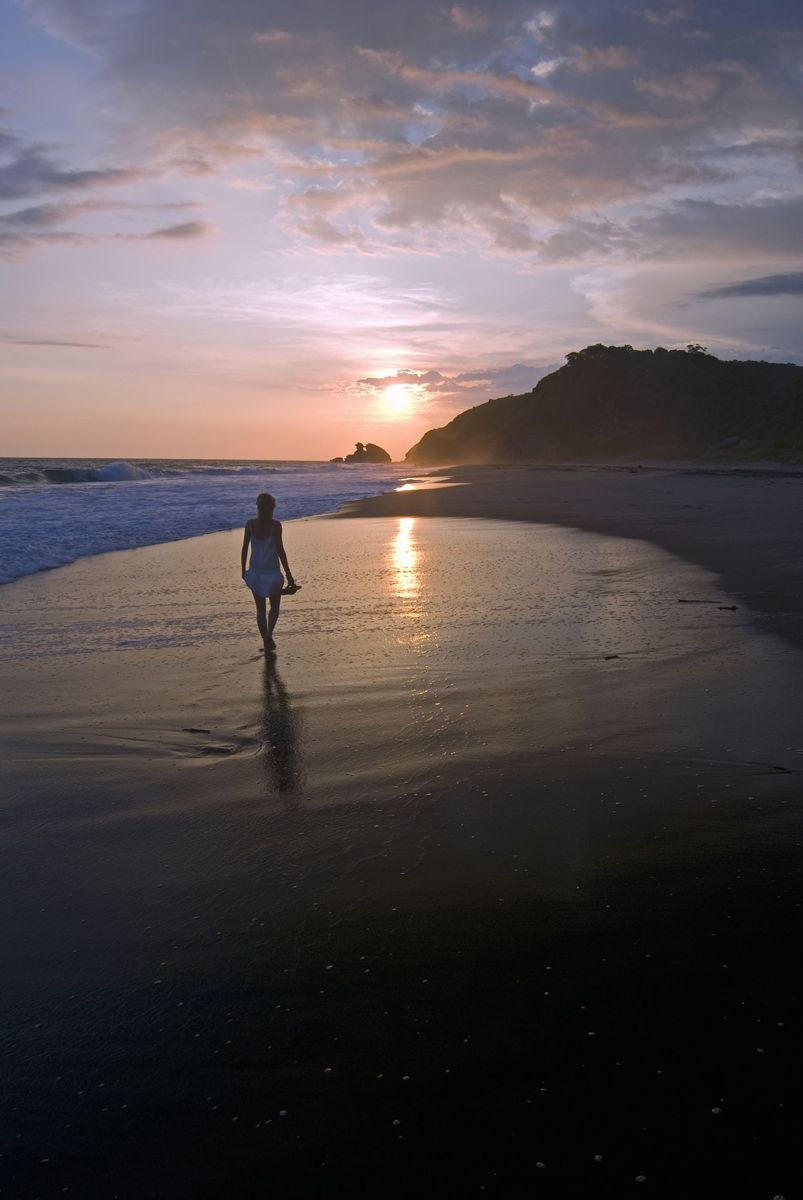
La spiaggia dell'amore
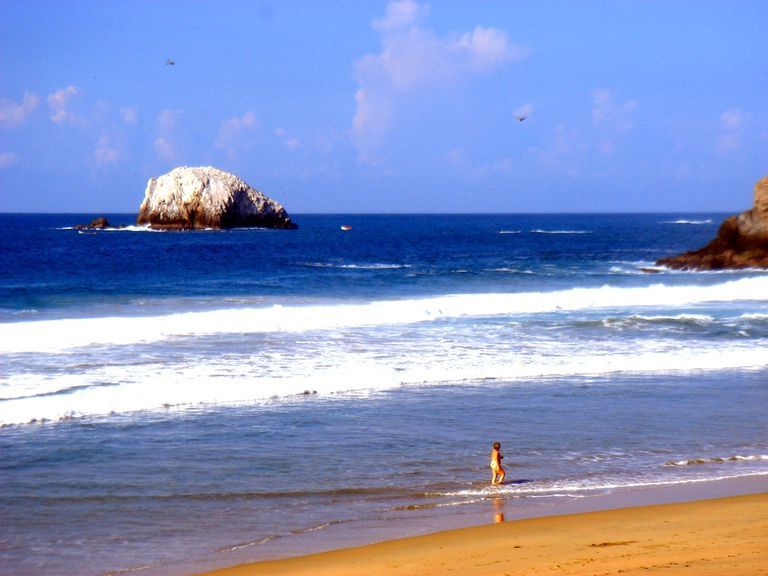 Spiaggia Zipolite. Flickr / Foto di Kevin Hutchinson / Licenza CC BY 2.0
Spiaggia Zipolite. Flickr / Foto di Kevin Hutchinson / Licenza CC BY 2.0
La spiaggia di Zipolite comprende più di due chilometri di sabbia dorata ed è fiancheggiata da alcune scogliere che, oltre a fungere da interruttore naturale, nascondono posti come Playa del Amor, dove il nudismo è più comune rispetto al resto dell'area .
Il nudismo in Zipolite non è obbligatorio; tuttavia, è richiesto di evitare di scattare fotografie sulla spiaggia per rispettare la privacy dei bagnanti.
Gite in barca
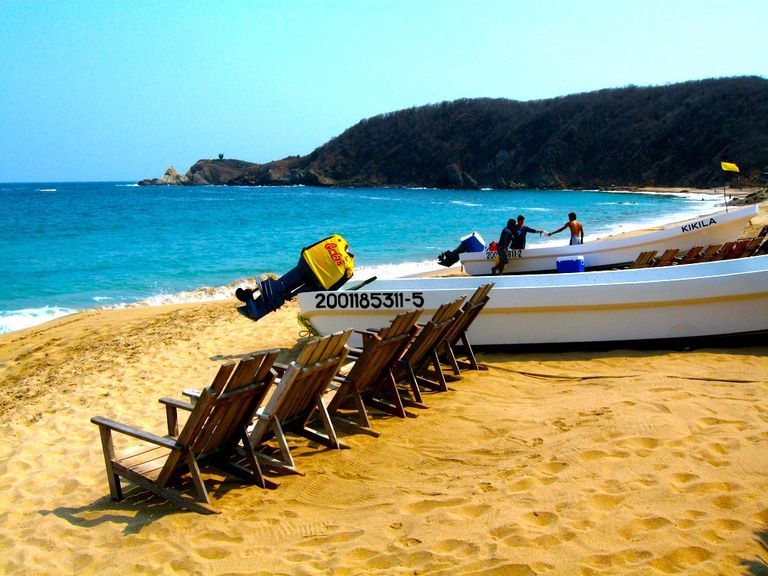 Barche in Zipolite. Flickr / Foto di Hector García / Licenza CC BY SA 2.0
Barche in Zipolite. Flickr / Foto di Hector García / Licenza CC BY SA 2.0
Tra le attività turistiche più popolari Zipolite sono le gite in barca offerti dalla gente del posto per conoscere i dintorni e praticare lo snorkeling.
Questi tour sono ideali per osservare l'arrivo della balena grigia, tra i mesi di gennaio e marzo, e per l'avvistamento delle tartarughe marine che vengono a deporre le uova nelle spiagge vicine.
Onde e surf
 Surfista sulla costa di Oaxaca. Foto di Christian Aslund / Collezione: Lonely Planet Images / Getty Images
Surfista sulla costa di Oaxaca. Foto di Christian Aslund / Collezione: Lonely Planet Images / Getty Images
In Zipolite ci sono zone di onde moderate ma ci sono anche quelle di correnti intense. Questo è sfruttato da dozzine di surfisti che hanno fatto di questa destinazione uno dei loro preferiti per migliorare le loro abilità nelle onde.
Se vuoi iniziare in questo eccitante sport, troverai luoghi lungo la spiaggia che offrono corsi per principianti.
Villaggio di Zipolite
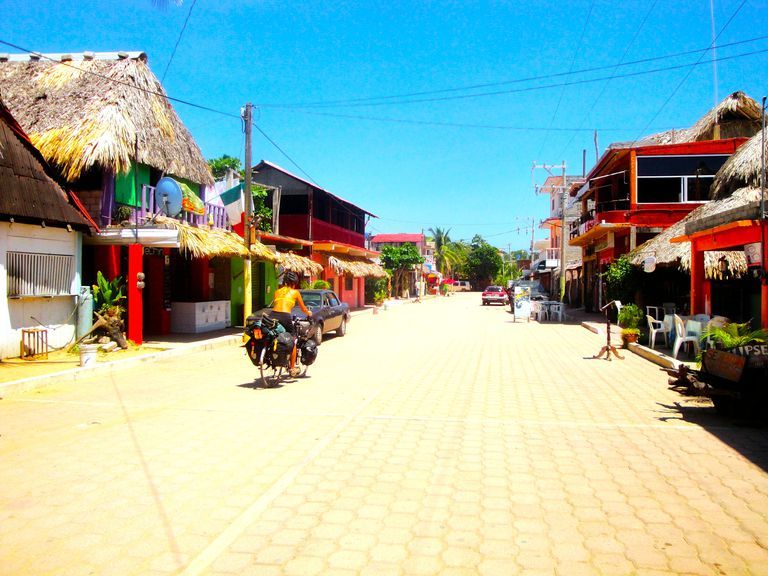 Strade di Zipolite. Fonte Flickr / Foto di Scott & Emily / Licenza CC BY 2.0
Strade di Zipolite. Fonte Flickr / Foto di Scott & Emily / Licenza CC BY 2.0
La città di Zipolite è piccola ma molto accogliente, soprattutto di notte, quando la gente passeggia per il suo viale alla ricerca di artigianato, ristoranti, bar e caffè. Non aspettarti di trovare grandi discoteche o club con musica ad alto volume, la vita notturna di Zipolite è più per le persone che amano l'atmosfera bohemien.
alloggio
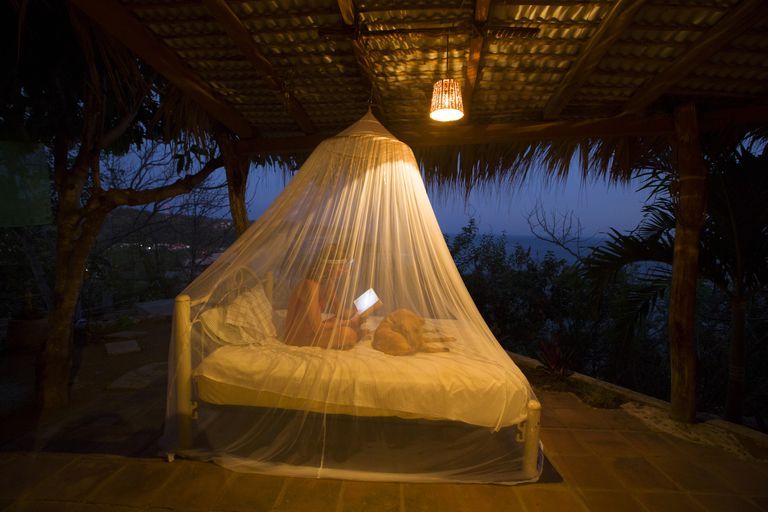 Alloggio a Zipolite. Foto di Jeremy Woodhouse / Holly Wilmeth / Collezione: Blend Images / Getty Images
Alloggio a Zipolite. Foto di Jeremy Woodhouse / Holly Wilmeth / Collezione: Blend Images / Getty Images
L'atmosfera hippie che circonda Zipolite si riflette anche nelle opzioni offerte per rimanere. Ci sono alternative per tutti i budget: dal noleggio di amache sotto palapas al mare, alle cabine e ai bungalow con tutti i comfort. I nostri suggerimenti sono i bungalow Nude, Posada Castillo Oasis e Casa Sol Zipolite.
Attrazioni nelle vicinanze
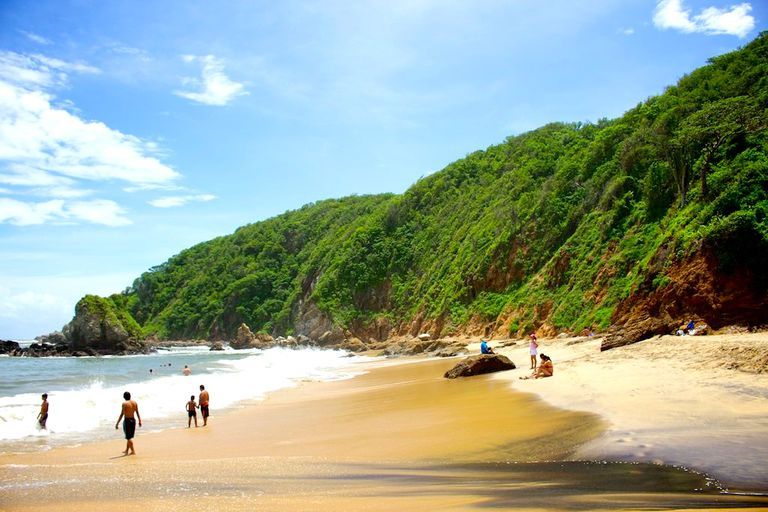 Mazunte, Oaxaca Flickr / Foto di Gabriel Balderas / Licenza CC BY 2.0
Mazunte, Oaxaca Flickr / Foto di Gabriel Balderas / Licenza CC BY 2.0
Puoi approfittare del tuo soggiorno a Zipolite per visitare luoghi vicini come la spiaggia di Mazunte, dove si trova il Mexican Turtle Center. Altri luoghi da non perdere nei dintorni sono Puerto Escondido, San Agustinillo e le Baie Huatulco.
Come arrivare
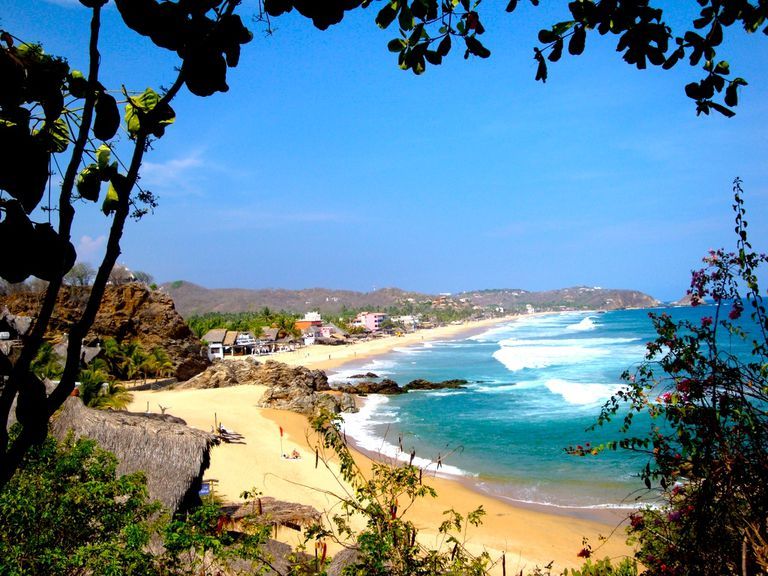 Panoramica di Zipolite. Flickr / Foto di Kevin Hutchinson / Licenza CC BY 2.0
Panoramica di Zipolite. Flickr / Foto di Kevin Hutchinson / Licenza CC BY 2.0
Il modo più semplice per arrivare a Zipolite è prendere un volo per Huatulco e dall'aeroporto per salire a bordo degli autobus o dei taxi che vanno a Pochutla e in seguito a Zipolite.
Un altro modo è dalla città di Oaxaca, anche se il viaggio richiede almeno sei ore in un'auto privata. In questo caso dovresti seguire la strada statale 175 in direzione di Miahuatlán e poi seguire le indicazioni per Puerto Angel e Pochutla.
Se viaggi in autobus troverai partenze dal centro di Oaxaca, Puebla e Città del Messico.
Thousands of manta rays surprise tourists in Oaxaca Mexico News Daily People in Puerto Escondido, Oaxaca, were treated to a surprise show when thousands of manta rays gathered in the shallow waters of a beach on ...
Thousands of manta rays surprise tourists in Oaxaca
People in Puerto Escondido, Oaxaca, were treated to a surprise show when thousands of manta rays gathered in the shallow waters of a beach on ...
Manta rays gather in the waters off the Oaxaca coast. ALEX KROTKOV
Thousands of manta rays surprise tourists in Oaxaca
Their presence was not unusual but the numbers were
Thursday, April 25, 2019
Thursday, April 25, 2019
Conoce la playa Zipolite, una playa sin tabú Explora Oaxaca Conoce la playa Zipolite, una playa sin tabú. Se busca incidir en la sustentabilidad. Luego de culminar el período vacacional de la Semana Mayor en ...
| Conoce la playa Zipolite, una playa sin tabú
Conoce la playa Zipolite, una playa sin tabú. Se busca incidir en la sustentabilidad. Luego de culminar el período vacacional de la Semana Mayor en ...
|
The Monarch Butterfly Migration to Mexico by Ted Campbell
The Monarch Butterfly Migration to Mexico
Posted by Ted Campbell
If I told you that, every year, millions of insects migrate thousands of miles from the eastern U.S. and Canada to the same part of central Mexico, would you want to go there to see them? Probably not, if you’re imagining roaches or locusts or something similarly horrible.
Fortunately, the protagonist of this voyage is the monarch butterfly, a pleasant creature to walk among as they gather in great groups on the trunks of tall oyamel fir trees in the mountain forests of Michoacan and the State of Mexico.

This migration is one of the largest in the world, certainly the largest in North America, and the only one by insects that includes the return trip. And it happens right above our heads every year—millions of butterflies following no leader but instinct.
Or is it something more than instinct? It’s still a mystery to scientists how these masses of butterflies return to the same specific areas every year, a relatively small region of the central Mexican plateau that’s about a four-hour drive from Mexico City.
Although the precise method is unknown—it may have to do with Earth’s magnetic field, the wind currents of the northern hemisphere, or some kind of insect collective unconscious, the purpose is clear: escaping the cold winters of the north, which the butterflies are far too sensitive to survive, for the perpetual spring weather of the Mexican highlands, like so many other northern visitors. Much of the Mexican altiplano is arid and desert-like, but the areas around its many mountain ranges have forest groves with enough humidity to support the needs of countless creatures, including the monarch butterfly.
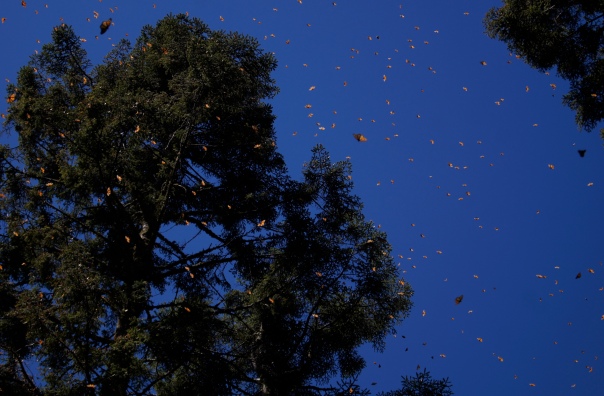
Another mysterious phenomenon is involved in this migration: the birth of a special generation that lives much longer than the average butterfly. Most monarchs live only a few weeks, but in late summer, the migratory generation is born, the final generation of the year. Also called the Methusula generation, named after the biblical character who lived 969 years, these butterflies have a lifespan of up to nine months, allowing them to migrate south to Mexico, gather together in the trees for warmth and protection, breed and produce the next generation.
These successive generations have the typical two-to-five-week lifespan, so they fly north in stages, laying eggs and dying along the way. About four generations later, once the voyage is over, the migratory generation is born once again, destined to travel south like their great-great-great grandparents did the year before.

These insects face plenty of obstacles on the way, in both the north and south. For instance, according to the Washington Post, 20 million monarch butterflies die every year from getting hit by cars.
In the U.S. and Canada, the main threat comes from a decline in milkweed, which the butterflies rely on for food. More factory farms and fewer milkweed plants means less food for the monarchs. The butterflies also face danger from the weather—one harsh chill on the way, and an entire flock can be wiped out.

In Mexico, the greatest threat comes from habitat loss, especially logging, which is why the Mexican government has designated eight butterfly reserves. Five are open for limited tourism. You must stay on designated trails, and touching the butterflies is forbidden.
Besides being important sources of food for creatures higher on the food chain, monarch butterflies are important pollinators, like bees. Therefore, conservation efforts are underway in both countries. It’s such an important issue that the fate of monarch butterflies was a topic of discussion during a summit of North American leaders Barack Obama, Peña Nieto and Stephen Harper in 2014 in Toluca, the nearest big city to the reserves. Afterwards, Michelle Obama planted milkweed and other plants favored by monarchs at the White House.
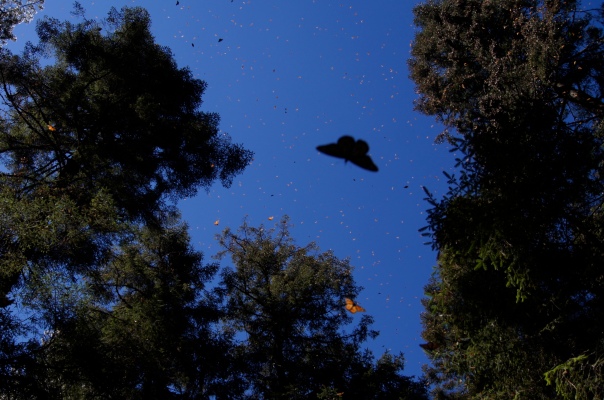
I visited the largest reserve in Mexico, El Rosario, in March of 2019. We left early from Toluca, the capital of the State of Mexico, taking the highway west to the state of Michoacan. More remote parts of Michoacan have a bad reputation for danger from drug gangs, but there’s little to worry about on this well-worn route between the monarch butterfly reserves and Mexico City. (Toluca is on the way.)
Two hours into the drive, as we grew closer to the reserve, a few butterflies fluttered on the side of the twisting road, but nothing like the dense clouds we hoped to see. No matter, we pressed on, and after about three hours on a smooth highway surrounded by low brown hills, patches of rolling forest, and small concrete towns, we reached the parking lot for El Rosario.
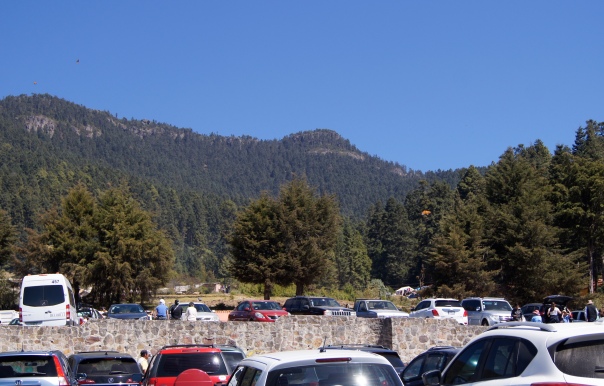
First there was an uphill walk on a twisting path lined with wooden structures containing small restaurants and vendors, most selling butterfly-related souvenirs: painted ceramic decorations, tablecloths, and t-shirts, all decorated with the familiar orange and black pattern. Many had buckets of fresh fruit for sale, including peaches, strawberries, and blackberries bigger your thumb. Smoke poured from open grills in front of the restaurants, while teenagers holding laminated menus called out the specialties of each.

The entrance to the reserve appeared after this gauntlet, a wide arch above the crowds. By now the butterflies were thick in the air. We paid the 50-peso entrance fee (about $2.50 USD) and entered the reserve.
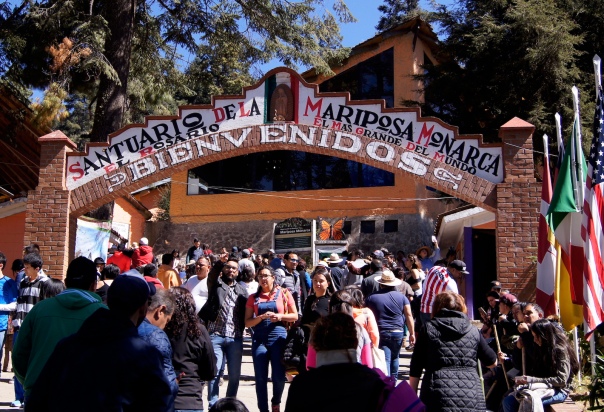
One long trail in a big loop went up and then down the mountain slope among the tall oyamel fir trees. A few other trails branched off from this loop, but they were either blocked off or for horses only. According to the guides selling horse rides, the butterflies were even thicker higher in the mountains and away from the crowds.
Some tree trunks were completely covered in butterflies, fluttering masses that resembled the leaves of dense creeper ivy in black and orange. The sky was full of them, the ground too, though mostly with corpses of the fallen. We passed several pools of muddy water where butterflies drank on the surface and from all sides.
The path took about two hours with slow walking and lots of stopping for pictures or to just take in the spectacle. With continuous walking, it would take about an hour. I couldn’t help but think that any other insect swarm might not be so pleasant, but the colorful butterflies instead made for a peaceful, beautiful sight. The light sound of fluttering wings was like a breeze through stiff leaves.
For the most part the butterflies stayed well above our heads, although regularly one or two would drift down to land on a shoulder or forearm. One of the park’s rules was to not touch any butterflies, and it seemed well respected for the most part. You had to watch your step as well, because many butterflies ended up landing on the path.
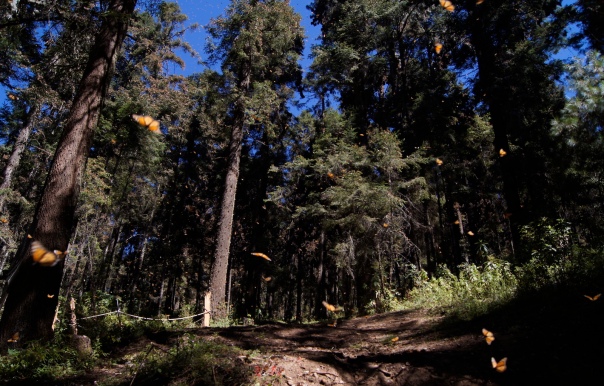
Once we left the park, we took a different route home, on narrow highways through the forested mountains of Michoacan to the magic town of El Oro, which translates to The Gold.
El Oro used to be a gold mining community that attracted prospectors from all over the world, especially from English companies, which is reflected today with names like Brockman for a large reservoir next to the town. Buildings like the Municipal Palace and the Juarez Theatre have art nouveau and neoclassical architecture that you don’t usually see in Mexican small towns, which are typically in the Spanish colonial style.

We ate lunch in the Vagon Express Minero restaurant inside an old converted train car in the center of town. When someone stood up or a waitress walked by, the whole car rocked back and forth with the motion. The food was ok; the atmosphere better.

I’d already been to Tlapujajua, another magic town just up the road, but never to El Oro itself. Both are nice and quite different—Tlapujajua is all winding cobblestone streets on the side of a mountain slope, while El Oro is relatively flat and laid out in a grid. Visiting both in one day would be easy, and would give a nice introduction to the tranquil, friendly Mexican magic towns.
The magic town designation is a program in Mexico to recognize and preserve the most beautiful and representative small towns in the country. At the moment there are 121. I’ve been to many—maybe 40 or 50—and each has something unique or interesting.
In El Oro, it’s certainly the ambiance, with qualities not seen elsewhere in Mexico—British names and wooden buildings, a train car restaurant, and an old train station across the street that’s now a museum. Besides the Tequila trains that leave from Guadalajara and the Copper Canyon train in the north, there are no passenger trains in Mexico, so these are rare sights.

Another good stop near the reserves is Valle de Bravo in the State of Mexico, which is in the opposite direction from El Oro and Tlapujajua. With its large reservoir for boat rides, tall mountains for parasailing or mountain biking, and pretty town center, Valle de Bravo is a popular weekend destination for people living in the madness of Mexico City. If you wanted to spend more than one day on your butterfly adventure, a small hotel in Valle de Bravo would be your best choice.
How to get there
Many websites offer tours to the butterfly reserves, some for thousands of U.S. dollars. Unless you’ve got the money and want a comprehensive scientific explanation of everything you’ll see, however, you don’t need a tour, especially considering the low entrance fees for the reserves. El Rosario was 50 pesos, about $2.50 USD, and I’m sure the other reserves have similar prices, if not the same.
All you need is a rental car and a GPS or a cell phone with the Waze app to help you navigate. The highways and roads are generally good but can become confusing once you leave the highway at Zitacuaro and pass through small towns on the way to the reserve. There aren’t many street signs in the towns—most are confusing grids of one-way streets, many with parked cars partially blocking the way. Here’s where you’ll need to follow Waze, or if there’s traffic, you can follow the cars in front of you—they’re probably going to the reserve.
The reserves are open from mid-November to March, with the best times for viewing butterflies from January to early March.
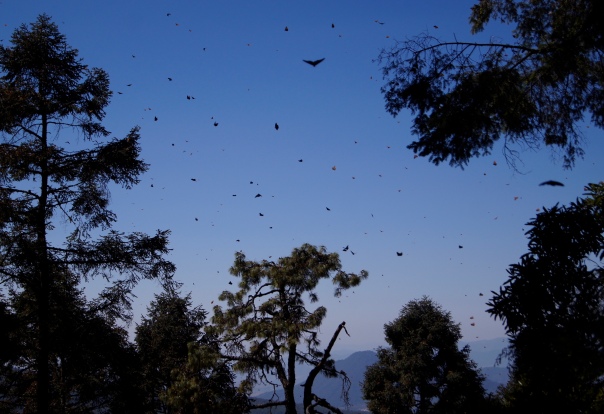
Sources and more information:
Michoacan travel website: http://michoacan.travel/es/lugares/santuario-el-rosario.html
USDA Forest Service website: https://www.fs.fed.us/wildflowers/pollinators/Monarch_Butterfly/migration/index.shtml
The Atlantic: https://www.theatlantic.com/science/archive/2015/12/monarch-butterflies-fly-south-for-the-winter/422115/
How to Travel Around Mexico by Bus for CHEAPIn "Mexico"
My Top Tips for Travelers to MexicoIn "Lessons from the Road"
Mexican Slang Master ListIn "culture"
About Ted Campbell
U.S./Canadian writer, translator and professor in Mexico. Travel stories and practical tips on my blog No Hay Bronca: nohaybronca.wordpress.com // Twitter: @NoHayBroncaBlog // Contact: nohaybroncablog (at) gmail.com
Subscribe to:
Posts (Atom)